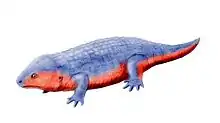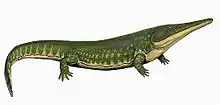Pasawioops
Pasawioops is an extinct genus of early Permian dissorophoid temnospondyl within the clade Amphibamiformes.
| Pasawioops | |
|---|---|
| Scientific classification | |
| Kingdom: | |
| Phylum: | |
| Class: | |
| Order: | |
| (unranked): | |
| Superfamily: | |
| Family: | |
| Genus: | Pasawioops Fröbisch and Reisz, 2008 |
| Species | |
| |
History of study
Pasawioops was first described from the early Permian fissure fills near Richards Spur in Comanche County, Oklahoma. It is known from three skulls from this locality. The holotype is a complete skull (reposited at the Sam Noble Oklahoma Museum of Natural History [OMNH]), while the referred specimens are larger but more incomplete partial skulls (one at the OMNH and the other at the Field Museum).[1][2] The taxon is also known from one specimen from the early Permian of Texas (reposited at the Museum of Comparative Zoology), being previously misidentified as a specimen of Tersomius texensis.[3]
Anatomy
Pasawioops has a relatively long and slender skull for an amphibamiform, with the posterior skull table not abbreviated as in more derived taxa. A tooth-bearing crest is found along the cultriform process, and the pterygoid bears two ridges of teeth. The teeth of Pasawioops are monocuspid and recurved. Unlike some derived amphibamiforms such as Gerobatrachus, the teeth are not pedicellate, or narrow at the base.[4]
Relationships
Pasawioops has long been recognized to be closely related to Micropholis from South Africa and Tersomius from North America. This clade was formalized by Schoch (2018) as the family Micropholidae.[5]
References
- Fröbisch, N.B.; Reisz, R.R. (2008). "A new Lower Permian amphibamid (Dissorophoidea, Temnospondyli) from the fissure fill deposits near Richards Spur, Oklahoma". Journal of Vertebrate Paleontology. 28 (4): 1015–1030. doi:10.1671/0272-4634-28.4.1015.
- Anderson, Jason S.; Bolt, John R. (2013). "New information on amphibamids (Tetrapoda, Temnospondyli) from Richards Spur (Fort Sill), Oklahoma". Journal of Vertebrate Paleontology. 33 (3): 553–567. doi:10.1080/02724634.2013.726676. ISSN 0272-4634.
- Maddin, Hillary C.; Fröbisch, Nadia B.; Evans, David C.; Milner, Andrew R. (2013). "Reappraisal of the Early Permian amphibamid Tersomius texensis and some referred material". Comptes Rendus Palevol. 12 (7–8): 447–461. doi:10.1016/j.crpv.2013.06.007.
- Anderson, J.S.; Reisz, R.R.; Scott, D.; Fröbisch, N.B.; Sumida, S.S. (2008). "A stem batrachian from the Early Permian of Texas and the origin of frogs and salamanders" (PDF). Nature. 453 (7194): 515–518. doi:10.1038/nature06865. PMID 18497824. Archived from the original (PDF) on 2011-07-26.
- Schoch, Rainer R. (2019). "The putative lissamphibian stem-group: phylogeny and evolution of the dissorophoid temnospondyls". Journal of Paleontology. 93 (1): 137–156. doi:10.1017/jpa.2018.67. ISSN 0022-3360.














